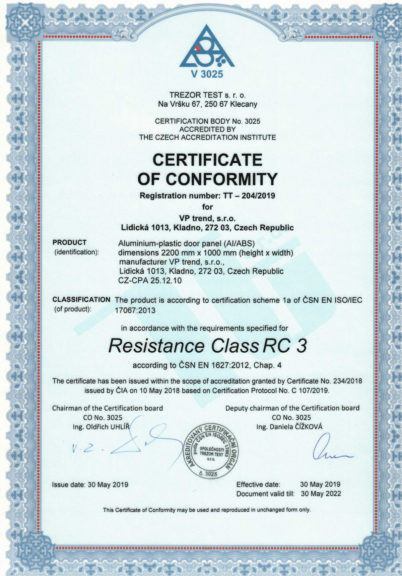VP trend door panels
are manufactured in a plastic (ABS), HPL, aluminium-ABS, and an aluminium design.
Basic design
The core of the panel is manufactured out of 20 mm thick layer of extruded polystyrene (XPS). This material is light, does not age and ensures the high isolation feature of the door panels. This core is intended for white plastic (ABS) door panels, for HPL door panels, for aluminium-ABS overlay door panels and for aluminium door panels.
Reinforced design
To raise the mechanical resistance and solve the increased stiffness in plastic (ABS) door panels we replace a part of the XPS isolation layer by a board from hardened polyurethane mixture (TPR) in 10 mm thickness. This construction is mandatory for plastic (ABS) door panels with (wood)decor surface. It is also mandatory for models with two-coloured panels – K101 to K112.
Design with heightened thickness
Is reached by expanding the XPS isolation layer to ensure the improvement of the warmth permeability coefficient value.
Overlay design
The outer (overlay) fair-face is manufactured from 2 mm thick aluminium. The outer aluminium plate surface is finished either with powder painting or decorative foil. It also may be finished with anodizing or special varnishing. The inner (non-overlay) fair-face of the door panel for aluminium doors is manufactured from aluminium plates with the basic thickness of 1,5 mm and for plastic (ABS) panels of 2 mm, and its fair-face layer consists of either acrylate (PMMA) or decorative foil. It is also possible to deliver all aluminium panels of the B Series as bifacial overlay (overlays the door leaf frame on both sides).
For extremely stressed doors
For restaurants offices and other public spaces is primarily intended a panel with the core of 20 mm thick board of hardened polyurethane mixture (TPR). However due to the higher value of the warmth permeability coefficient the valid certificates of the VP trend s.r.o. company on plastic door panels do not apply to this design and it has several special characteristics and differences compared to the standard design.


